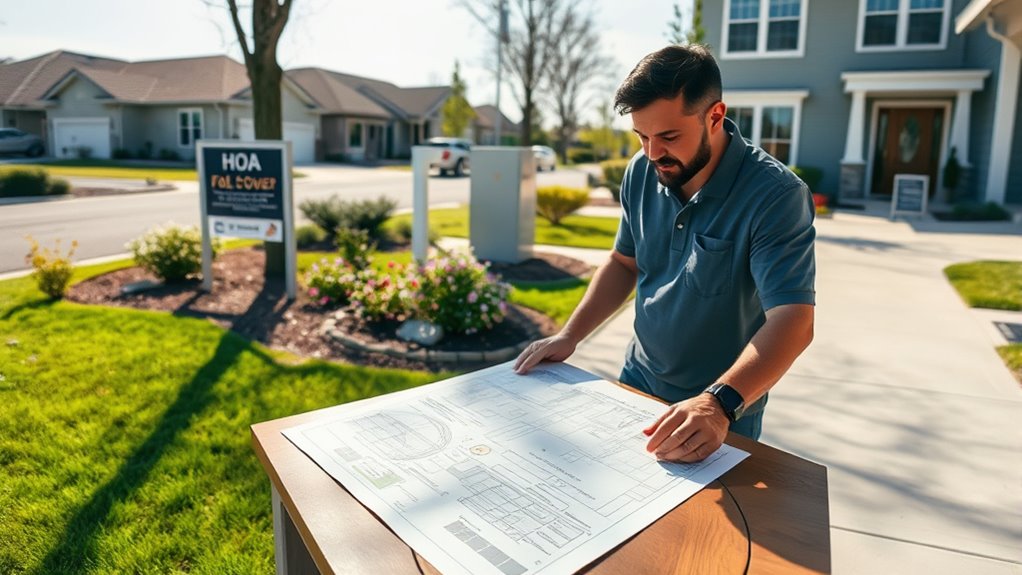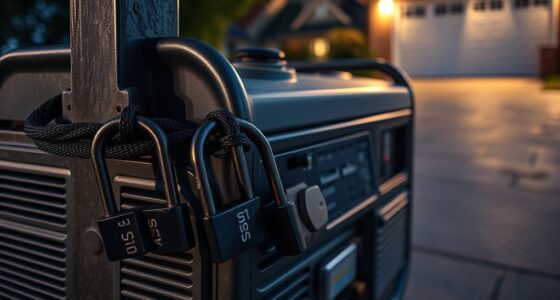To coordinate with your HOA or city before installing a backup generator, start by reviewing their rules and regulations on exterior modifications and noise limits. Engage with your HOA’s architectural review committee early and submit a formal approval request. Contact local authorities to understand permits and building codes, and prepare all necessary documentation like site plans and electrical diagrams. Communicate regularly with officials and your contractor to make certain of compliance. If you keep going, you’ll find more detailed steps to streamline the process.
Key Takeaways
- Review HOA covenants, bylaws, and community guidelines related to exterior modifications and equipment placement.
- Submit detailed plans and applications to the HOA’s Architectural Review Committee for approval.
- Consult local building codes and obtain necessary permits before installing the backup generator.
- Communicate early with city or county authorities to clarify permit requirements and inspection procedures.
- Coordinate landscaping, screening, and placement to ensure compliance with community aesthetics and safety standards.
Review Your HOA’s Rules and Regulations on Generator Installations
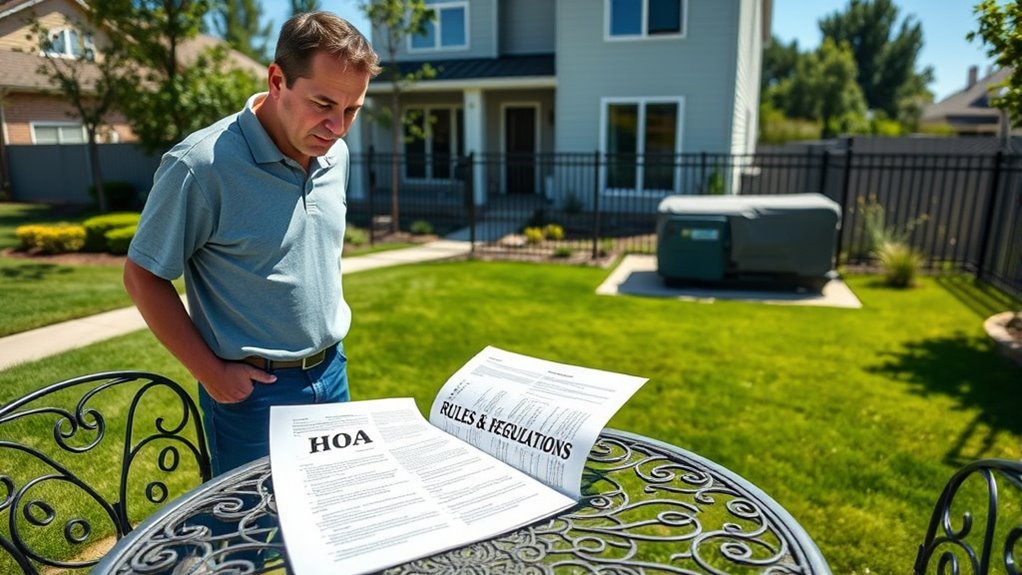
Before planning your backup generator installation, it’s essential to review your HOA’s rules and regulations. Start by examining the covenants, conditions, restrictions, and bylaws related to exterior modifications and utility structures. Look for specific clauses on generator placement, noise limits, fuel storage, and screening requirements. Verify whether any prohibitions exist or if you need to notify the HOA before installation. Pay close attention to sound-level decibel restrictions to ensure your generator complies. Additionally, check if landscaping or fencing is required to hide or soften the visual impact of the generator. Understanding these guidelines helps you avoid violations, fines, or removal orders. Researching HOA policies beforehand can save you from potential delays or conflicts during the process. Incorporating compliance strategies and understanding community standards ensures your project proceeds smoothly and adheres to all community standards. Recognizing the importance of proper documentation can also facilitate smoother approval processes and ensure your installation remains compliant throughout. Being aware of regulatory requirements related to safety and environmental impact can further streamline your approval process and prevent future issues.
Engage With Your Hoa’s Architectural Review Committee or Board
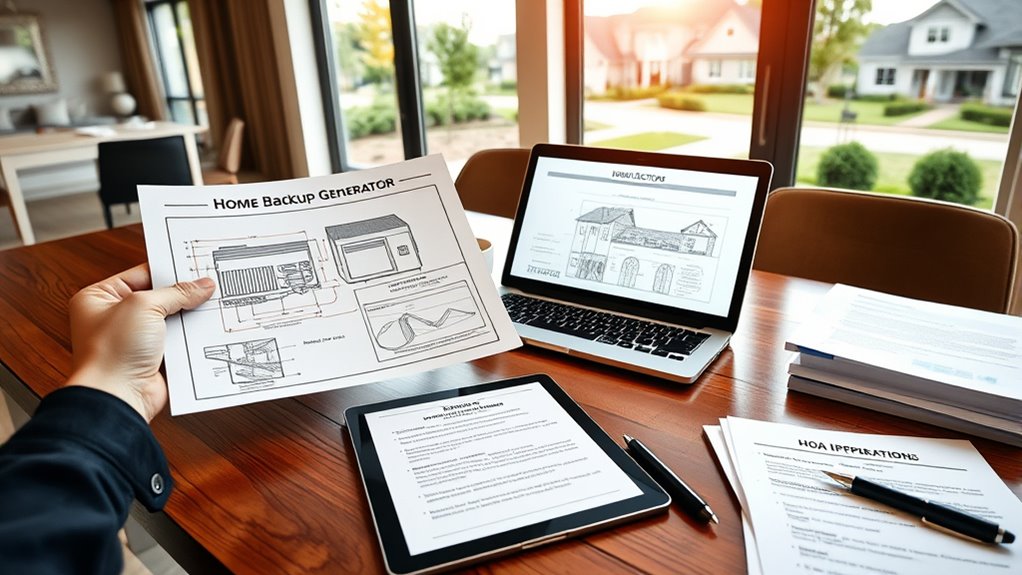
Engaging with your HOA’s Architectural Review Committee (ARC) is a crucial step to guarantee your backup generator installation meets community standards. The ARC enforces architectural guidelines outlined in your HOA’s CC&Rs and bylaws, reviewing applications for modifications like generator installations. They evaluate whether your proposal aligns with aesthetic standards and relevant zoning or building rules. Expect to submit a formal application and receive a written response within a set timeframe, often 30 days. The ARC can recommend approval, rejection, or suggest modifications to ensure compliance. They also educate residents on guidelines and maintain documentation for transparency. The ARC’s review process is outlined in your community’s governing documents, which specify the procedures and criteria for approval. Building a cooperative relationship with the committee ensures your project aligns with community standards while respecting the review process. Additionally, understanding community aesthetic standards can help you tailor your plans to increase the likelihood of approval. Familiarity with zoning and building regulations can further streamline your approval process and prevent potential delays. Developing a clear understanding of permitting requirements can also facilitate smoother project approval and ensure compliance with local laws. Knowing the local building codes can help you prepare your application more thoroughly and avoid unnecessary revisions.
Understand Local Building Codes and Permitting Requirements
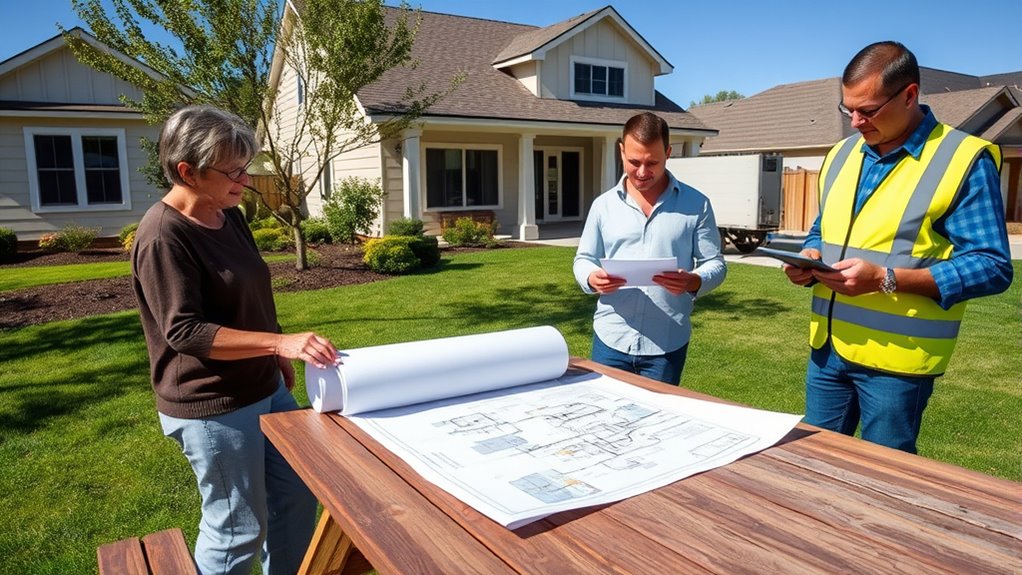
Before installing a backup generator, you need to understand the local building codes and permit requirements. Some installations require permits connected to your electrical system, and failing to get approval can lead to fines or removal. Make sure to verify what’s needed with your city or county and gather all necessary documentation upfront. Permits ensure safety and compliance, so checking with your local building department early can help prevent project delays. Additionally, understanding local codes and regulations can help you select the appropriate equipment and ensure your installation meets all safety standards. Being aware of home electrical standards can further help you avoid potential code violations. Consulting with a licensed electrician familiar with local regulations can also streamline the approval process and ensure adherence to all requirements. Furthermore, reviewing inspection procedures can prepare you for any inspections needed during the permitting process.
Permits and Approvals
Understanding permit requirements is a crucial step in installing a backup generator, as rules and procedures can vary considerably depending on your local municipality. Most areas require permits for standby generator installations, especially for electrical work, which almost always needs a licensed contractor to apply. Some communities permit small portable generators without permits for short periods, but larger or permanent setups need detailed applications. These typically include site plans, electrical diagrams, load calculations, and fuel storage details. The process involves submitting accurate, complete documentation and coordinating with local authorities. Be prepared for review and inspection stages, and factor in possible delays. Always check with your city or county to ensure compliance and streamline approval. Additionally, understanding local building codes and regulations can help prevent potential violations and fines. Being aware of permitting procedures can also facilitate smoother approval processes and avoid unnecessary rejections.
Safety and Compliance
Ensuring your backup generator meets local building codes and permitting requirements is essential for a safe and compliant installation. First, verify that your setup follows local regulations for fuel storage, electrical connections, and generator placement. Second, obtain any necessary permits before starting installation; unpermitted work can lead to fines or safety issues. Third, make certain your generator installation adheres to safety standards such as proper grounding and exhaust placement to prevent hazards. Remember: 1. Keep generators at least 20 feet from windows, doors, and vents to avoid carbon monoxide buildup. 2. Use GFCI outlets and proper grounding techniques to prevent electrical shocks. 3. Regularly inspect cords, connections, and fuel storage areas for safety compliance. Additionally, consulting local building codes and regulations ensures your installation aligns with current safety standards and requirements. Incorporating inspection procedures and routine maintenance checks can further promote safety and compliance. Conducting a thorough site assessment prior to installation can help identify potential hazards and ensure adherence to all safety guidelines. Performing a permitting process early in your planning can streamline approval and prevent delays. Following these steps helps protect your household and ensures your generator operates safely within local requirements.
Communicate With Municipal Authorities for Permits and Compliance
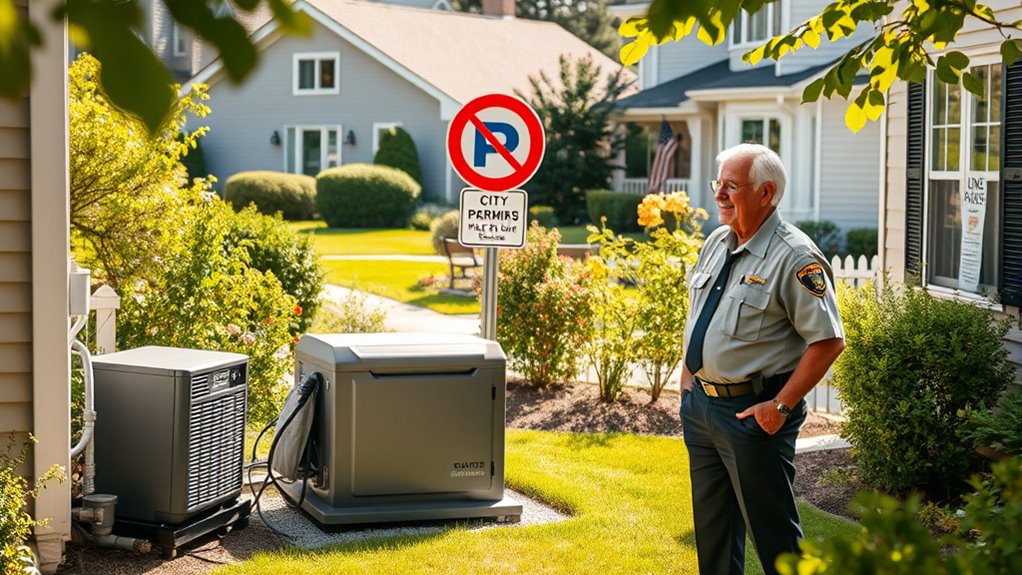
You need to contact your local building department early to understand what permits are required and what documentation is needed. Preparing detailed site plans, electrical diagrams, and generator specs will help facilitate the approval process. Scheduling appointments promptly ensures you stay on track and avoid unnecessary delays. Additionally, understanding permitting requirements and regulations can help ensure your backup system is both efficient and well-maintained. Consulting with local authorities about regulatory compliance can further streamline your approval process and prevent future issues. Being aware of security considerations related to backup installations can also help you address potential vulnerabilities proactively.
Understand Local Regulations
Communicating early with your local building departments is crucial to steering permit requirements and ensuring compliance with regulations. This step helps you understand what’s needed and prevents delays. Most municipalities require permits for permanently connected generators, especially for electrical or gas work. Some areas may allow small portable generators without permits but restrict usage times. To stay on track, you should:
- Contact your city or county building departments to clarify permit needs.
- Prepare site plans, electrical diagrams, and specifications for review.
- Use permit management software to streamline your application process.
Prepare Necessary Documentation
Preparing the necessary documentation is a critical step in obtaining permits and ensuring compliance with local regulations. You’ll need to submit completed application forms signed by you or an authorized representative, along with manufacturer’s specifications and installation instructions for your generator model. Detailed site plans or plats of survey are essential, showing generator placement, setbacks, easements, vents, and gas line layouts. Electrical line diagrams describing connections and materials must be included for review. Additionally, zoning information like district classification and property setbacks needs verification from municipal offices to confirm land-use compliance. Providing thorough, accurate documentation upfront helps streamline the approval process, minimizes delays, and guarantees your installation aligns with all safety, environmental, and community requirements.
Schedule Permit Appointments
Scheduling permit appointments promptly is essential to keep your backup generator project on track. Early booking helps you account for review times, which can range from days to weeks. To stay organized, follow these steps:
- Submit your application as soon as possible, ensuring all required documentation and fees are prepared.
- Confirm whether licensed contractors need to submit permits on your behalf.
- Keep communication lines open for updates or additional requests from the permitting department.
Prepare Documentation and Design Plans for Approval

Before submitting your plans for backup generator or solar panel installation, you need to gather extensive documentation and detailed design plans that meet HOA and city requirements. Your plans should include precise placement of equipment, such as distance from property lines and visibility considerations. Include architectural drawings, dimensions, and screening methods like fences or plantings to minimize visual impact. Wiring routes, conduit locations, and fuel storage details must also be documented. Alongside these, compile supporting materials like manufacturer specs, safety certifications, and proof of licensed contractor involvement. Confirm your documentation addresses noise mitigation and safety compliance. Organizing everything clearly helps streamline approvals. Consulting with HOA and city officials early ensures your submission aligns with all guidelines, reducing the risk of delays or rejection.
Coordinate Landscaping and Screening to Meet Community Standards

Coordinating landscaping and screening efforts is key to guaranteeing your backup installation blends seamlessly with your community’s standards. To do this effectively, you should:
- Use approved plant palettes to match community aesthetics and avoid invasive species.
- Follow guidelines for lawn furniture and sculptures, especially in visible front-yard areas.
- Ensure garden sizes and placements comply with HOA restrictions to maintain visual harmony.
Frequently Asked Questions
Are Portable Generators Allowed Under HOA Rules or Only Standby Units?
You can usually use portable generators without HOA approval if you follow safety and noise guidelines, but rules vary. Standby units often require HOA approval due to their permanent installation and appearance. Check your HOA covenants for specific restrictions. Confirm portable generators are operated outdoors, away from windows, and stored safely. Always confirm with your HOA to avoid violations and ensure proper use, especially during emergencies or temporary needs.
What Are the Typical Noise Limits for Generator Installations in Residential Areas?
Think of your generator as a neighbor’s lawnmower—ideally, it shouldn’t disturb the peace. Typical residential noise limits range from 45 to 60 dB during the night and up to 85 dB during the day. Many areas require generators to stay below 75 dB, roughly equivalent to a loud conversation. To keep harmony, choose low-noise models, use sound barriers, and guarantee your install complies with local regulations.
How Long Does the Approval Process Usually Take With HOAS and Local Authorities?
The approval process with HOAs and local authorities usually takes between a few days to over a month. It depends on your municipality’s workload, the HOA’s review schedule, and how complete your application is. If you coordinate well and submit thorough documentation, you can speed things up. Keep in mind, larger cities or complex installations tend to take longer, so plan accordingly to avoid delays.
Can Medical Needs Influence HOA Approval for Backup Generator Installation?
Your medical needs can markedly influence HOA approval for a backup generator. Under the Fair Housing Act, HOAs are required to provide reasonable accommodations for medical necessities, which can include installing a generator. You should submit documentation from your healthcare provider to support your request. Be prepared for the HOA to review safety, aesthetic, and noise considerations, but your medical necessity can strengthen your case for approval.
Are There Specific Fuel Storage Regulations That Homeowners Must Follow?
You need to follow specific fuel storage regulations to stay compliant. Most neighborhoods limit fuel to small containers, like two five-gallon approved ones, and restrict storage to detached sheds or garages. Aboveground tanks over 300 gallons usually need permits, and underground tanks are regulated for leak prevention and safety. Always check local rules, as HOAs or city codes might impose stricter limits, ensuring safe storage and avoiding penalties.
Conclusion
By steering the maze of rules and approvals, you’ll turn your backup generator project into a smooth sailing adventure. Think of it as planting a seed that blooms into a harmonious addition to your home, all while respecting your community’s garden. When you stay in sync with your HOA and city, you’re weaving a tapestry of cooperation that keeps your neighborhood vibrant and connected. With preparation and communication, your backup install will stand strong like a sturdy oak amid the breeze.

